Editor’s note: This article was last updated on 30 May 2023 with more information about the components of a product roadmap, product roadmapping tools, and steps to fill out the product roadmap templates described herein. We’ve also added some FAQ about product roadmaps.
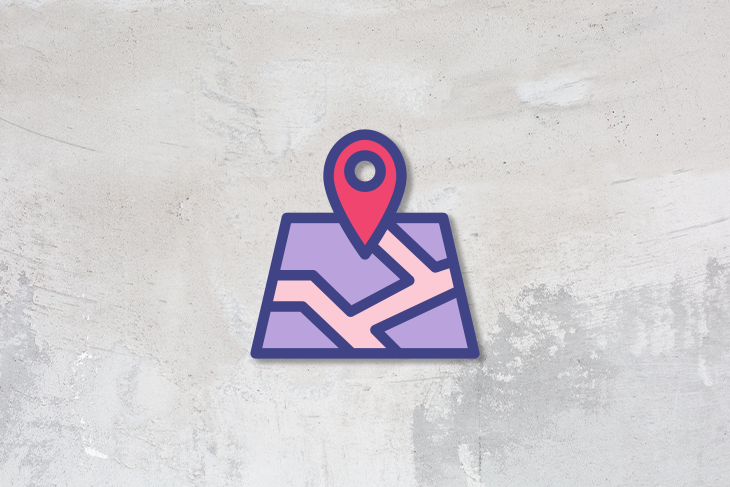
The world of product management thrives on planning and visualization, and one tool stands out as an embodiment of both: the product roadmap.
A product roadmap is a strategic document that outlines the vision, direction, and progress of a product over time. It highlights what a product team plans to achieve and how they intend to do it.
The ability to craft a good product roadmap is an essential PM skill. In this guide, we’ll define exactly what a product roadmap is and look at some examples. We’ll also walk through how to build a product roadmap and offer some general guidelines to help you choose the right format.
If you’d like to follow along as you go, these product roadmap templates can help you get started.
A product roadmap is a shared, living document that outlines the vision and direction of your product throughout its lifecycle.
The roadmap, at its most basic level, articulates what you are building and why. It also lays out the team’s strategy for delivering value and serves as a plan for executing the overall product strategy.
The primary purpose of a product roadmap is to communicate the strategic direction of the product. It aligns all stakeholders — product managers, developers, marketers, executives, and even customers — around the product vision and goals.
Beyond communication, a product roadmap serves as a guiding tool for decision-making, helping teams prioritize initiatives and features based on their alignment with the product vision and goals.
While there is no one-size-fits-all approach to building a product roadmap, a well-constructed roadmap typically includes the following components that, together, help convey the product’s trajectory:
Building a product roadmap involves the careful balancing of business objectives, customer needs, and technical feasibility. It’s about understanding what your market wants, what your team can deliver, and how these align with your company’s goals.
Let’s look at an example. Suppose you’re a product manager for a productivity app:
Embarking on the journey of creating a product roadmap may seem daunting at first because it depends heavily on your organization’s unique goals and circumstances. However, broadly speaking, the following steps will help ensure you cover all your bases when building your product roadmap:
The product vision is the long-term destination for your product. It should be an inspiring and guiding statement that provides direction for your product over the next few years.
The vision should be broad enough to allow for flexibility, yet specific enough to provide clear direction.
Product goals are SMART (specific, measurable, attainable, relevant, time-bound) objectives that, when achieved, will bring the product closer to its vision.
Your goals should be aligned with the overall business objectives and provide a clear path to the realization of the product vision.
Initiatives are the high-level efforts needed to achieve the product goals. They should be strategic and directly contribute to the achievement of the product goals.
Initiatives can span multiple releases and typically involve multiple features or tasks.
Features are the specific functionalities or tasks that need to be completed as part of an initiative. They provide the granular details of what will be developed and delivered.
Detailing the features involves breaking down the initiatives into actionable tasks that can be assigned to the development team.
Timeframes provide a rough estimate of when the initiatives and features will be delivered. These estimates are not set in stone but provide a guideline for when to expect certain features.
Estimating timeframes involves considering factors such as resource availability, technical complexity, and business priorities.
There are debates within the product community as to which roadmap format is the best. The truth is, none of them is perfect. The best format will depend on your organizational culture, company stage, team setup, and the nature of your product.
Regardless of which format you choose, every product roadmap should consist of three foundational elements:
Each element can come in several variations. Let’s review them one by one:
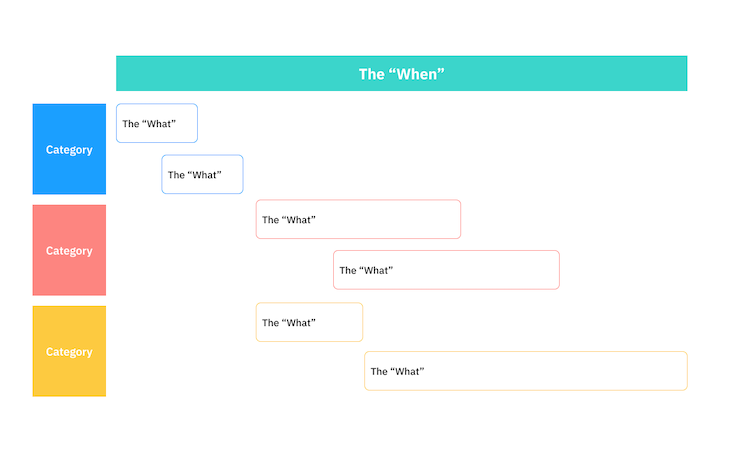
This is the horizontal axis on a roadmap that indicates the timeline of your initiatives. It can be displayed in the following formats:
Mapping your initiatives on a calendar is the most common way of visualizing a roadmap. The calendar should be either quarterly or monthly. Any longer unit will be too broad, and any shorter unit will be too unrealistically precise.
The benefit of using a calendar-based roadmap is that anyone can understand it without further explanation. The downside is that whenever you give people a timeline, it will be treated as a promise, no matter how much you insist it is not.
Below is an example of a calendar-based product roadmap:
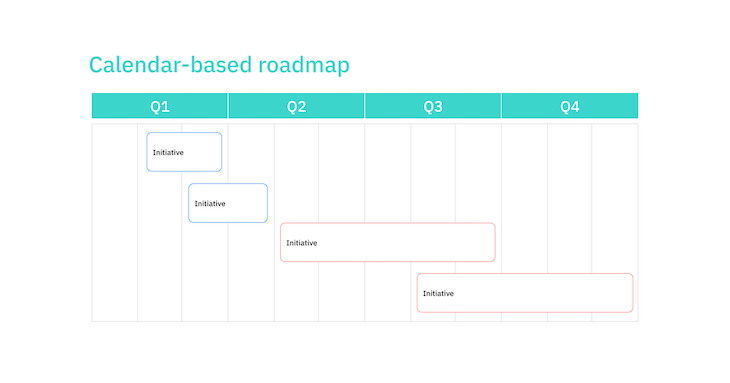
Click here for a calendar-based roadmap template.
Note: Before attempting to fill out the template, be sure to select File > Make a copy from the menu above the spreadsheet.
The Now-Next-Later roadmap was invented by Janna Bastow, co-founder of Mind the Product. The idea is to remove the false certainty of absolute dates by replacing them with relative timeframes:
A Now-Next-Later roadmap can help your organization escape the certainty trap. Instead of wasting time discussing when things will be done, it forces a discussion on what is more important.
However, while the idea of omitting dates makes sense in theory, it’s not always practical.
If internal stakeholders are always asking, “How long are we talking here? Weeks? Quarters?”, you might want to rethink whether the Now-Next-Later roadmap is bringing more focus or confusion.
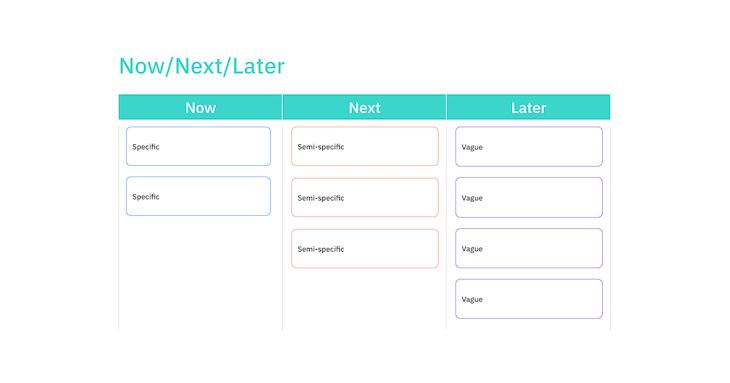
Click here for a calendar-based roadmap template.
Note: Before attempting to fill out the template, be sure to select File > Make a copy from the menu above the spreadsheet.
These are the core items on your roadmap that represent what you will be working on. They might include:
Also in this section:
A product team’s main responsibility is building features users want, so it makes sense that features make up the bulk of product roadmaps out there.
However, if you think features are the only thing that should go on a roadmap, then you would be wrong.
There are many activities that a product team has to perform to facilitate the creation of new features, such as user research, tech debt cleanup, internal tool implementation, and product launch.
Including these non-feature initiatives on a roadmap can increase transparency and help educate the rest of the company about why a seemingly small feature can take so much time.
Again, this doesn’t mean you should put every task on the roadmap. Make sure to only include initiatives that offer strategic alignment.
A feature is a solution to a user problem, but you often don’t know what the best solution is ahead of time.
If you are not sure what features to commit to, it is best to simply state the problems you want to solve on a roadmap. This leaves you with more room to explore different solutions and gets everyone to focus on the core problems.
In addition to stating the problems you want to solve, you can also describe the outcomes you want to achieve on a roadmap.
These outcomes can be either user outcomes (e.g., “Users can find what they want easily”) or company outcomes (e.g., “Increase conversion rate by 50 percent”).
They don’t have to be written as quantitative metrics, but it always helps to have some objective criteria by which to define success.
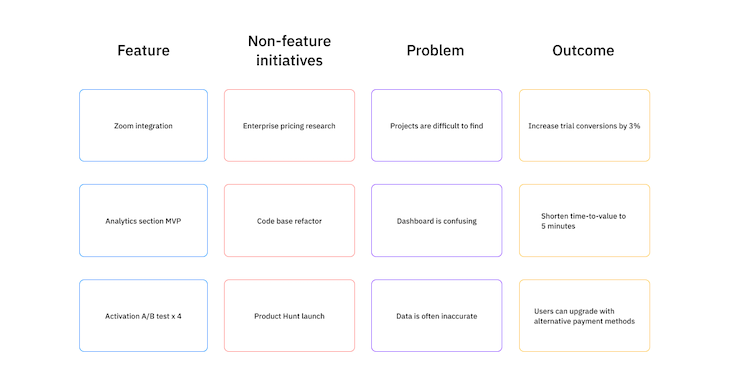
You can use categories to group initiatives on a roadmap. They can be displayed as either swimlanes or tags.
Product teams commonly categorize initiatives on the roadmap by things like:
You should not group initiatives by more than two dimensions on a given roadmap. After all, categories are there to help internal stakeholders digest your roadmap. Introducing too many concepts will do the opposite.
If you really have to, you can create different versions of the roadmap for different audiences.
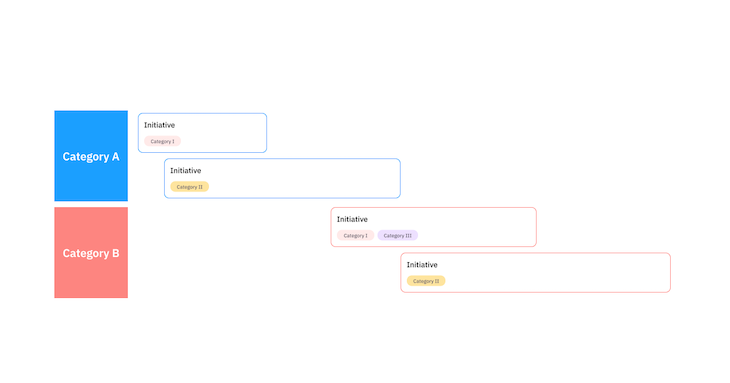
Remember, a product roadmap needs to be tailored to your specific context. Blindly following what other companies (especially FAANG) do is like wearing an outfit tailored-made for someone else — it will look sloppy.
There is no set formula that will tell you how to create a perfect roadmap, but I will share some general guidelines and best practices for choosing the best roadmap format for your product and business:
We’ve created customizable templates for each product roadmap format described above (you can access each template in Google Sheets below):
Note: Before attempting to fill out a template, be sure to select File > Make a copy from the menu above the spreadsheet.
These templates are also available in Miro and Figma formats.
Time-based product roadmaps are a great way to visualize your product’s journey and development over time:
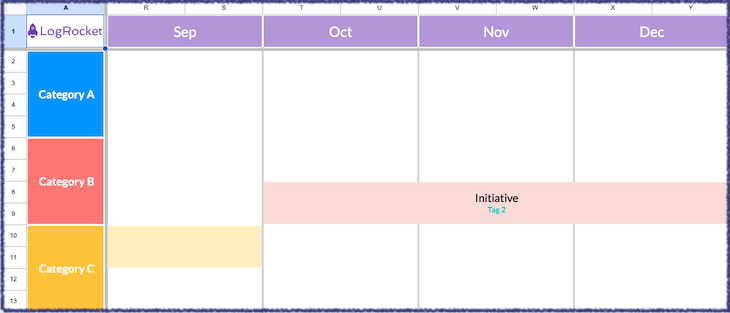
To fill out the monthly product roadmap template, take the following steps:
Remember, the key is to keep it updated as your product and strategy evolve over time.
To fill out the quarterly product roadmap template, follow the same steps as above, but split your timeframes into quarters rather than months:

The same steps apply to the Now-Next-Later roadmap template, except you’re not defining concrete timelines for any of your initiatives. Instead, this roadmap template calls for organizing initiatives into one of three buckets — things to do now, things to do next, and things to do later:
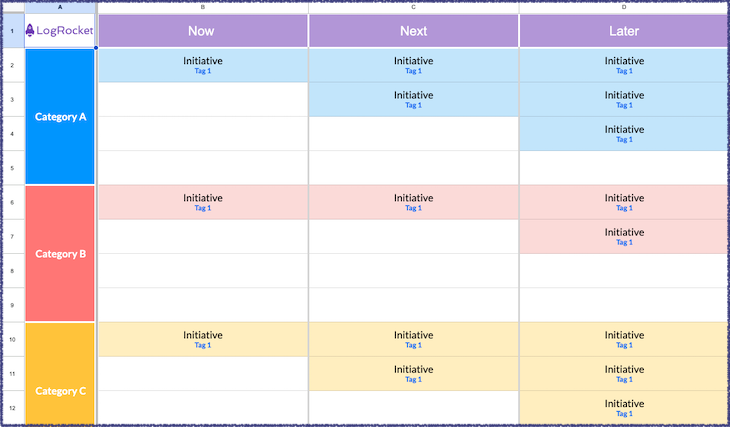
While both a project plan and a product roadmap provide a framework for organizing and executing work, they serve different purposes and operate at different levels of granularity.
A project plan is more detailed and short-term focused, outlining specific tasks, responsibilities, and deadlines. A product roadmap, on the other hand, is more strategic and long-term oriented, detailing the high-level initiatives and features that contribute to the product vision.
The table below outlines the key differences between a project plan vs. a product roadmap:
| Project plan | Product roadmap | |
|---|---|---|
| Purpose | A detailed plan for executing a specific project within a specific time frame | A high-level strategic document outlining the direction and progress of a product over time |
| Level of detail | Very detailed, outlining specific tasks, responsibilities, and deadlines | High-level, describing the initiatives and features that contribute to the product vision |
| Time horizon | Short-term, typically spanning weeks to months | Long-term, typically spanning months to years |
| Flexibility | Less flexible due to the need for precise planning and coordination | More flexible to accommodate changes in business strategy or market conditions |
(Image: A side-by-side comparison of a project plan and a product roadmap with key differences highlighted)
In the context of agile product management, a product roadmap is a strategic tool, but with an added layer of flexibility.
An agile product roadmap is designed to adapt to changes, learning, and feedback over time. It prioritizes outcomes over outputs, focusing more on achieving goals and solving customer problems than on delivering a fixed set of features.
For example, instead of committing to deliver Feature X in Q2, an agile roadmap might commit to solve Customer Problem Y in Q2, leaving open the possibility of what that solution might look like.
Whereas a typical product roadmap might show expected release dates for these enhancements, in agile, the notion of sticking to deadlines becomes counterintuitive:

Agile development requires an ability to respond to change and address evolving needs at any particular moment. Agile teams also spend less time estimating and forecasting how long something will take and put that time back into experimenting and actually building the product.
As a result, we expect things to change in agile and dates quickly become wishful thinking or empty promises.
Another core principle of agile is fixed capacity. We achieve this by creating stable, long-lived, cross-functional teams. In doing so, we fix our capacity, meaning that scope and/or time are the dimensions that shift. Therefore, it is not possible to pin features to dates in agile.
When we do want to fix dates in agile, scope remains flexible. Both scope and time cannot be fixed in agile:
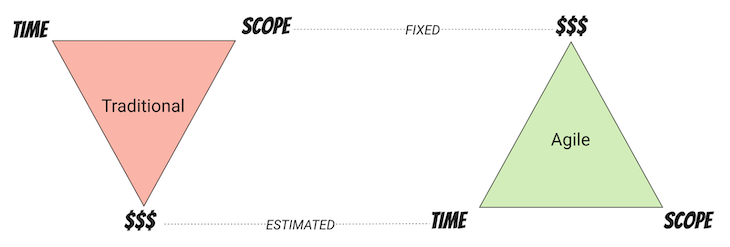
An agile roadmap, therefore, removes the notion of product deadlines. It still maintains the concept of time (i.e., feature A will come before feature B), but nothing is tied to a specific date.
Product roadmapping software makes it simpler to keep track of large to-do lists, backlogs, and ideas. A roadmapping tool helps to keep the various teams and stakeholders involved in building a product on track to meet development goals. It can also facilitate online collaboration and communication between employees.
Choosing the right product roadmap software will completely depend on your team, its work style, and your budget and business goals. You’ll want to consider tools that enable you to more effectively:
Popular tools and software for creating product roadmaps include:
If you’re on a fixed budget, you could do worse than the following free tools for product roadmapping:
Product roadmap strategy involves making decisions about what to include on your roadmap and why. It’s about aligning your roadmap with your product strategy and business objectives.
During the planning phase, you might consider factors like market trends, competitive landscape, customer feedback, resource availability, and more. Your roadmap should serve as a visual representation of your strategic decisions so that you can clearly and effectively communicate your vision, goals, and expectations to key stakeholders.
Below are some considerations and best practices for communicating your strategy and short- and long-term plans to key stakeholders with your product roadmap:
It’s the product manager’s responsibility to build and manage a live roadmap that is fluid and resilient. They must convince stakeholders why the investment makes sense, obtain buy-in and the support system from inside and outside the organization, set expectations, and deliver a sense of excitement about what’s to come.
You can generate the support they you to successfully push for investment in a new product or feature by:
The first step in defining a product is to convince leadership that the offering aligns with the corporate strategy. While a product vision presents this alignment and a cash flow analysis demonstrates the value, it becomes real when leadership views the product roadmap.
The information included in the roadmap should give the executive team confidence that the offering is viable and worthy of organizational and financial support. It should include a clearly defined goal and a list of key steps or milestones toward achieving that objective.
A product roadmap should also articulate the overall product strategy and provide context to explain how it will help the team deliver on the goals spelled out in the product vision.
The key to building a good product roadmap is to understand your audience. A roadmap designed to gain buy-in from company leadership looks very different from one meant to appeal to customers. This is where a theme-based product roadmap can really come in handy, as described in this helpful guide by Andrea Saez.
In the following sections, we’ll explain how to create a product roadmap that will gain buy-in from executive leadership, the organization as a whole, partners, and customers.
A roadmap for leadership needs to capture when the MVP will be available, the target customers, expected revenue, and demographics of product usage. Stakeholders will want to know when attaining total market potential is feasible (general release) and considerations for upsell opportunities. With each feature, they will want to understand the purpose and sequencing.
The main purpose of a product roadmap is to educate and convince leadership that the product or feature is worth their investment. Another key reason is to seek their direction. You have some of the best minds on the call, so you might as well leverage it!
Leadership also needs to know the KPIs you monitor and will expect updates on how you track periodically. A product roadmap sets the stage for critical thinking. It sets expectations on when volumes will ramp so that leadership has a direction on the short and long-term outlook.
Be creative about what you present as a roadmap. Typically, presentations demonstrate a timeline at the top, the critical features, and a two-line summary. That isn’t sufficient in many cases. The narrative that captures the essential customers at each phase is vital.
Creating product roadmaps for peer organizations requires a much broader perspective beyond the engineering team.
For example, consider the operations team when processing claims; manual processing might be necessary for some scenarios when starting a new initiative. Your ability to identify these scenarios, the number of transactions expected every month, and features that make such processing unnecessary can make or break a project. Consider every team the product touches internally, including legal, procurement, analytics, and implementation (we will gate to sales in a bit).
Turning our attention back to the product development team, understanding what “done” looks like is very important. While a customer or leadership-facing roadmap does not need a detailed view, this is crucial for a development team. The roadmap must break down further to articulate parts of a more extensive feature that needs prioritization versus later enhancements.
Implementation and customer success teams need clarity on when features are available in sandbox and production environments to prepare their teams with the requisite training. The analytics team needs communication when new datasets are obtainable to drive KPI measurements.
Development teams need a roadmap to devise the product architecture. Most successful products work because of a tacit alignment between product management and engineering.
I find it valuable to work with the team to get creative about breaking down a more significant feature. My rule of thumb is that if it takes more than two weeks to develop, a further breakdown might be necessary. This feature breakdown translates into a more detailed roadmap that drives cross-functional alignment.
Note that the feature split should be outcome-driven — it shouldn’t be a breakdown to measure progress alone. You may ask, why wouldn’t a leadership team care about this? To put it simply, they would, and communication is critical if the feature split is significant enough. Frequently, these splits are a matter of UX enhancements, not revenue-blocking ones.
System integrators (SIs) are frequently the medium between the product and the user. Their adoption could make or break your offering.
Consider an ERP system. Product companies such as SAP rely on system integrators such as Accenture to deploy and manage the solution for the client.
Imagine that your product’s enhancement (however well-intended) breaks existing customization. Suppose the SI didn’t see this coming, or this occurs frequently. In that case, the SI might stop upgrading the product because the client now considers the downtime due to an upgrade to be unacceptable. Don’t be that product!
Webinars are a great way to relay the product roadmap for the next quarter. While that constitutes a good start, it is critical to document, especially UI or API changes, and present a forewarning of possible compatibility issues. The bottleneck isn’t the work to prepare for an upgrade but showing poorly in front of the client.
Customers expect your product to provide immediate relief to a current pain point while also demanding that it goes above and beyond.
For an example, take this tale of two vendors. In one of my previous roles, our operations depended heavily on solutions from third-party vendors. Without getting into specific details, both vendors offered overlapping products.
The pain point was that data resided in their systems. Vendor 1 did not provide a standard interface to retrieve data for deeper analytics. Vendor 2 did, but there was considerable pressure to set up our AI and automation environments.
During our next quarterly, we requested both vendors to present their roadmaps. When vendor 2 showed us its roadmap, it was apparent that their reps had listened to our needs. More crucially, the roadmap included well-defined timelines. Vendor 1 had plans to deliver significant updates, including ones that would have made our issues disappear. Unfortunately, it never presented anything aside from a motivational speech. This eliminated vendor 1 and we consolidated our solutions through Vendor 2.
The account manager for Vendor-1 admitted offline that he never got the product team’s backing to present anything to the customer. Put yourself in their shoes: Why would a sales manager sell your product to the customer? If you cannot provide a roadmap, pricing, and timing for a product, you might as well not build it.
Another consideration is building a suite of product capabilities that enables incremental opportunities. Think of your product as a set of Lego blocks where the outcomes are more remarkable than the sum of the parts. You are overdelivering to most of your customers when you build something as an all-inclusive product.
A customer-facing roadmap is typically a quarterly or monthly timeline highlighting significant enhancements to the product. It needs to relay in about 15–20 words why the feature drives value for them.
The sales team prefers a similar snapshot. However, I recommend customizing it depending on the sales team’s audience.
Knowing what feedback is crucial versus what is noise is essential to building sustainable products.
When introducing a new product, you can always expect feedback, which is god. However, most of it is tactical, and suggestions tend to resolve a symptom rather than a root cause.
As an example, once I had a customer demand a feature for a unique scenario. The sales team was adamant that the product was a no-go until we added the feature. We got on a call with the customer, talked through it, and determined it was an arcane rule that wasn’t even valid.
In other cases, I’ve seen product teams turn an enhancement request into an opportunity for a new revenue stream. The point is to separate the signal from the noise. Don’t be afraid to reprioritize your product roadmap when there is a good rationale.
Get on a call with the customer and have an open-ended discussion; you might discover unpolished diamonds that could lead to new avenues for success. Once you deliver an MVP, get close with the users and measure the product’s results against expectations. Understand the critical pain points. Then, brutally prioritize them against ROI, ease of development, the product’s readiness, and the market.
A well-designed product roadmap can be a powerful tool to help product managers secure buy-in from stakeholders and communicate their vision across the organization. It provides clarity, fosters alignment, facilitates communication, guides decision-making, and ultimately, helps drive product success.
Understanding how to create a product roadmap — and, more importantly, the power it can wield when communicated effectively — is a key step in the product manager career development journey and a crucial factor in getting any product development lifecycle off on the right track.
In most cases, your roadmap should focus on the upcoming six to 18 months.
It is very rare for a product team to produce a meaningful plan any further into the future. If you ask 10 product managers how long they tend to stick to their roadmaps, nine of them will tell you less than three months.
Generally speaking, you should avoid committing to deadlines because software product development is full of uncertainties. There is no point making promises when you can’t fulfill them.
Unfortunately, the real world has constraints we can’t bypass, which sometimes makes deadlines a necessary evil. Don’t be afraid to impose deadlines if you have to, as long as you understand that they are the exception, not the rule.
It is perfectly fine to combine multiple approaches on the same roadmap.
For example, you can:
As a product manager, you own the backlog. Make sure to capture backlog items, drive transparency within the organization, and provide a rationale.
The product roadmap is a fluid document; it may evolve based on a wide range of parameters, such as a change in organization’s strategy, a shift in the market or user behavior, or the arrival of a new competitor.
The backlog needs to be regularly updated and realigned to keep up with changes in the product roadmap. It’s common for user stories and tasks to become outdated during this process, so you should remove these irrelevant items from the backlog as soon as you receive clear-cut direction from the stakeholders.
Remember that product management is 70 percent science and 30 percent craft, so get creative!
LogRocket identifies friction points in the user experience so you can make informed decisions about product and design changes that must happen to hit your goals.
With LogRocket, you can understand the scope of the issues affecting your product and prioritize the changes that need to be made. LogRocket simplifies workflows by allowing Engineering, Product, UX, and Design teams to work from the same data as you, eliminating any confusion about what needs to be done.
Get your teams on the same page — try LogRocket today.

Great product managers spot change early. Discover how to pivot your product strategy before it’s too late.

Thach Nguyen, Senior Director of Product Management — STEPS at Stewart Title, emphasizes candid moments and human error in the age of AI.

Guard your focus, not just your time. Learn tactics to protect attention, cut noise, and do deep work that actually moves the roadmap.

Rumana Hafesjee talks about the evolving role of the product executive in today’s “great hesitation,” explores reinventing yourself as a leader, the benefits of fractional leadership, and more.